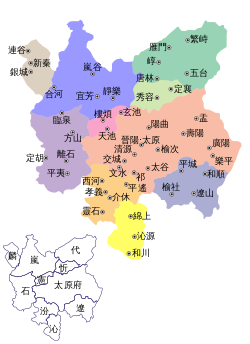
Back Severní Chan Czech Han du Nord French Han Utara ID Han del Nord Italian 北漢 Japanese 북한 (십국) Korean Умард Хань улс Mongolian Noordelijke Han Dutch Północne Han Polish Han do Norte Portuguese
Han 漢 | |||||||||
|---|---|---|---|---|---|---|---|---|---|
| 951–979 | |||||||||
 The Northern Han in 951 | |||||||||
| Capital | Taiyuan | ||||||||
| Common languages | Chinese | ||||||||
| Religion | Buddhism, Taoism, Confucianism, Chinese folk religion | ||||||||
| Government | Monarchy | ||||||||
| Emperor | |||||||||
• 951–954 | Emperor Shizu | ||||||||
• 954–968 | Emperor Ruizong | ||||||||
• 968 | Emperor Shaozhu | ||||||||
• 968–979 | Emperor Yingwu | ||||||||
| Historical era | Five Dynasties and Ten Kingdoms Period | ||||||||
• Established | 951 | ||||||||
• Ended by the Song dynasty | 979 | ||||||||
| Currency | Chinese cash, Chinese coin, copper coins etc. | ||||||||
| |||||||||
| Today part of | China | ||||||||
The Northern Han (simplified Chinese: 北汉; traditional Chinese: 北漢; pinyin: Běi Hàn) was a dynastic state of China and one of the Ten Kingdoms during the Five Dynasties and Ten Kingdoms period. It was founded by Liu Min (Emperor Shizu) as a continuation of the Later Han dynasty founded by his brother Liu Zhiyuan (Emperor Gaozu). The Northern Han lasted from 951 to 979, when it was conquered by the Northern Song dynasty.